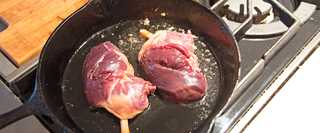Crispy Confit of Duck
Slow-cooked in their own rendered fat, duck legs become a tender delicacy
Slow-cooked in their own rendered fat, duck legs become a tender delicacy
By Scott Leysath - thesportingchef.com
Making duck legs palatable requires slow cooking with moderate to low heat in some form of liquid or oil to help turn tough meat into a tender delicacy. The classic French confit (pronounced "con-fee") method involves cooking somewhat
cured meat slowly in its own fat. The combination of curing the meat in salt and then cooking it slowly in oil inhibits bacterial growth. Since refrigeration didn't exist when confit was introduced, this cooking method was a means to
keep meat longer without spoilage. Today, it's all about tenderness and flavor. You might think that the end result of simmering meat in rendered fat would be a greasy duck or goose leg. Not so.
Duck fat has become a hot item during the past decade or two, and if you buy it commercially it will cost you plenty. The good news is that this delicious lipid can also be rendered from the trimmed fatty parts of mallards, pintails,
wigeon, and gadwalls. I wouldn't recommend turning divers, sea ducks, and darker-fleshed birds into duck fat, however, because the flavor can be a little strong.
To render the fat from dabblers, simply place the birds in a skillet over low heat and add just enough water to cover them. Increase the heat to medium-high until the water boils; then reduce to low and simmer uncovered for an hour or
so. The liquid will turn murky and then clear. After 45 minutes, pour the rendered duck fat through a strainer into a heat-safe container. Rinse the strainer, pat it dry, and then line it with a paper towel. Now pour the hot liquid
through the strainer again into another heat-safe container to remove the smaller bits. Once the fat has cooled, store it in the refrigerator or freezer.
Prior to cooking, rub the duck or goose legs liberally with the salt cure. You can use either a store-bought product or coarse salt with some added seasoning. If you are short on duck fat, add bacon grease, lard, or olive oil to just
cover the legs.
Preparation Time: 12-24 hours for the salt cure
Cooking Time: 3 1/2 - 4 1/2 hours
Makes: 4-6 appetizer servings
Step 1. Combine the salt with the next 4 ingredients and mix well. Place the duck legs in a large bowl and sprinkle the salt mixture over them. Toss to coat evenly. Transfer the legs to a shallow container, sprinkle any leftover salt
mixture over them, cover, and refrigerate for 12 to 24 hours.
Step 2. Preheat the oven to 225deg;F. Rinse the duck legs with cold water and pat them dry. Place the legs in a shallow baking dish in a single layer. Pour the duck fat over the legs to just cover them. Cover and place in the preheated
oven for 3 to 4 hours or until the meat pulls easily away from the bone.
Step 3. Once tender, allow the legs to cool. Before serving, place them in a medium-hot skillet until the skin is crispy.
Cooking with Duck Fat In addition to imparting deliciousness to everything it touches, duck fat is mostly monounsaturated, which means it's a "good" fat. Use it in place of butter or olive oil to add rich, savory flavor to roasted
potatoes and vegetables-and even popcorn.

Ducks Unlimited uses cookies to enhance your browsing experience, optimize site functionality, analyze traffic, and deliver personalized advertising through third parties. By continuing to use this site, you agree to our use of cookies. View Privacy Policy